
While our customers are wholesalers, Packard knows that you, the contractor, have a choice. You are often presented with many buying options, and being well-informed about your purchase can help make your job easier and more successful. Our Tech Tips are also very helpful for our wholesalers as we present product information that can help as contractors have questions.
This is why we have dedicated a section of our site for contractors and wholesalers. In this section, you will find helpful product tips, tools and some clips from our training classes. We’ve also provided a distributor locator so you can find the nearest wholesaler who can give you access to Packard products.
How to Replace the Blower Motor in a Home Furnace and AC System/ Written by 'The Practical Mechanic'
How to Replace the Blower Motor in a Home Furnace and AC System
(with step-by-step photo guide)
The following post consists of a detailed picture guide for replacing a worn-out or failing blower motor in your home furnace and/or air-conditioning system.
The following is a step-by-step instruction for installing an EC Max motor, please do not attempt this unless you are a licensed contractor.
How to Know When Your Furnace/AC Motor Needs to be Replaced
One of the most common indicators that you need to replace your furnace and AC blower motor is that it will become very noisy. Eventually the system will just stop blowing air altogether. Often there will be a buzzing sound indicating that the motor is unable to start and has overheated.
A couple of things you should check are the capacitor and the fan itself. If the capacitor is bad, it will often bulge or leak. You can tell that through visual inspection. If something has blocked the fan, this can also cause the motor to short out. Check to make sure nothing is blocking free motion of the fan.
If the fan has been damaged in any way, you may need to replace it. The fan is balanced for smooth operation, it damage has occurred so that it is no longer balanced, it can become noisy and reduce system efficiency. It is also more likely to fail in a short time.
Choosing the Right Motor
Many older home furnace and A/C units use traditional Permanent Split Capacitor (PSC) motors to power the fan. These are induction-type motors and both windings are energized during operation. Because they require power to generate the induction field, they are less efficient than Electronically Commutated Motors (ECMs).
ECMs use a brushless DC permanent magnet and so require less energy to run, and can decrease energy usage by as much as 75% (ref - nih.gov). They have the added advantage of more control in operation.
Due to the increased efficiency of these motors, the US government has mandated the installation of ECMs in all gas and oil burning furnaces (as of July 2019) to reduce energy consumption.
The motor I am installing in this guide is the Packard EC Max motor which is an ECM. It is 80% efficient as compared to the 55-65% efficiency of the PSC motor that was in my system originally. It is also significantly quieter to operate.
The price of a replacement motor is fairly comparable if you compare the OEM replacement PSC to the ECM motor, especially when you consider that with the PSC motor you should also replace the large capacitor.
The average useful life of an ECM is more than twice that of a PSC motor (ref). In large part due to the fact that the motor ramps up more slowly rather than just abruptly turning on and stressing the motor and the entire HVAC system.
Tools and Supplies Needed:
-
New Blower Motor (EC Max)
-
Flat-bladed Screwdriver
-
Vise Grips
-
Needle-nose Pliers
-
Socket Set
-
This repair will take about 2-3 hrs and cost about $200 to $300 if you do it yourself. I estimate that hiring someone to perform this repair will cost about $1000-$1500, depending on where you live.
Replacing a Blower Motor - Step by Step
-
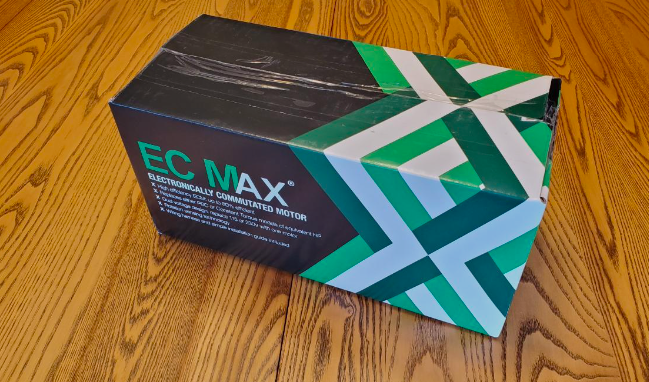
-
Alright, let's get started! The first step is to unbox your new blower motor.
The motor is packaged along with a wiring harness, several jumper wires, voltage selector plugs, and an instruction manual. For a detailed description of how to assemble the wiring harness to the motor, follow the calm voice of the presenter in this video.
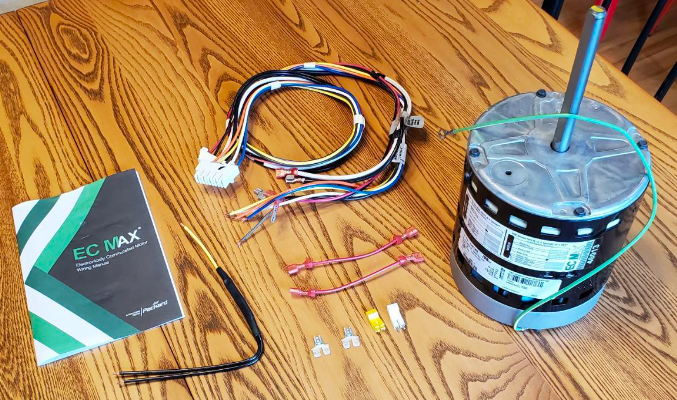
The first is a voltage plug. Use the yellow plug for 230v and the white for 115v. I am replacing a 115v motor, so I used the white plug, as indicated in writing on the side of the motor.
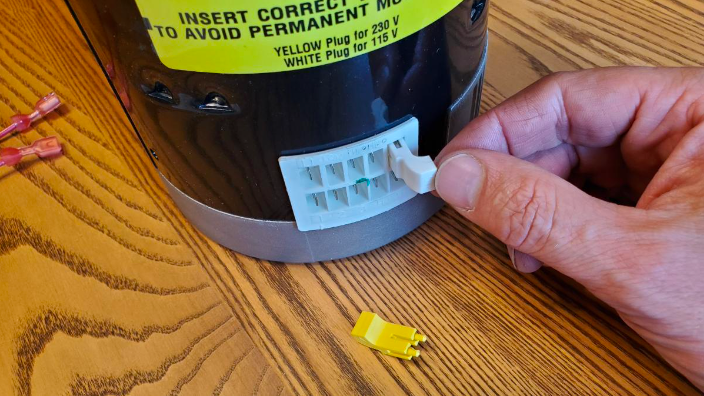
The wiring harnesses are pretty straightforward to connect, as they only fit in a certain way. See the image below.
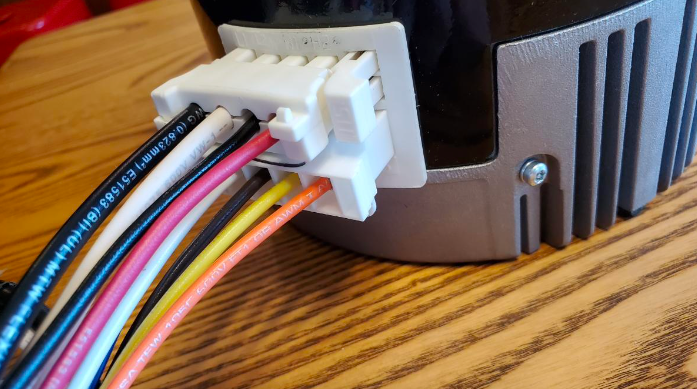
At this point, the motor wiring is attached, and we are ready to go to install it.
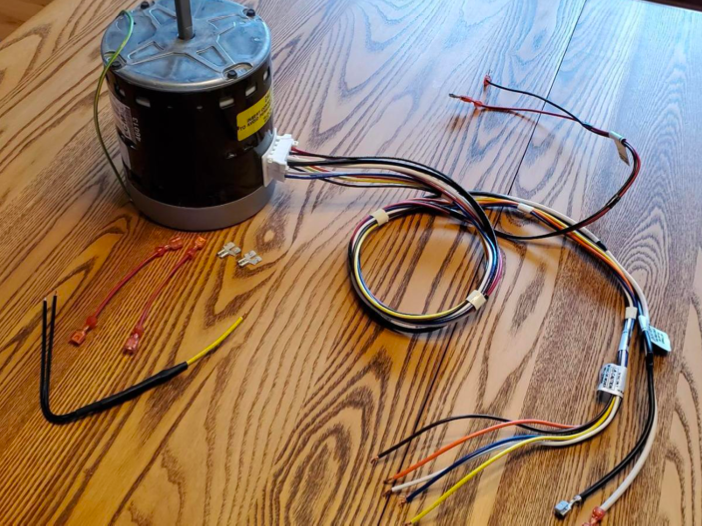
In addition to the instruction manual that comes with the motor, there is a wiring diagram on the side of the motor itself. In this case, I am replacing a standard blower motor (PSC), so I followed the wiring diagram for changing from the PSC to an ECM motor, as shown below:
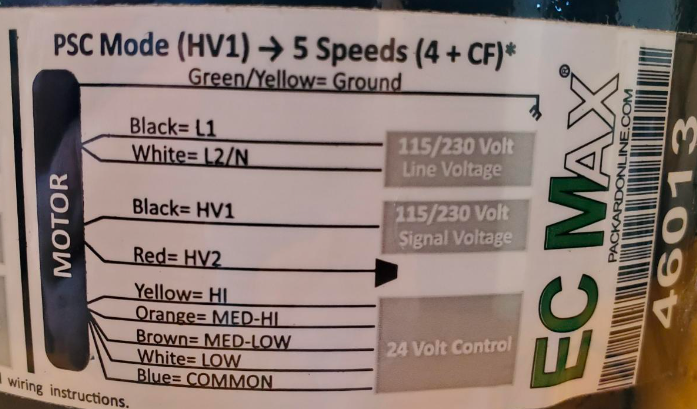
For purposes of safety, and before you do any work on the furnace and AC systems, be sure to turn off the circuit breakers to both of them. If your furnace has an off switch, turn that off as well.
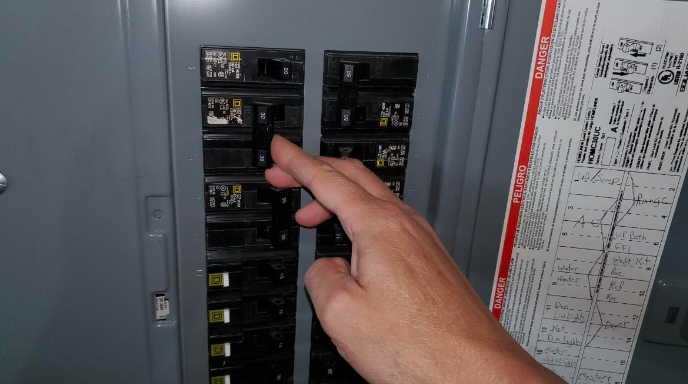
This is the Carrier blower system that I am working on. Remove the access panel to get at the blower.
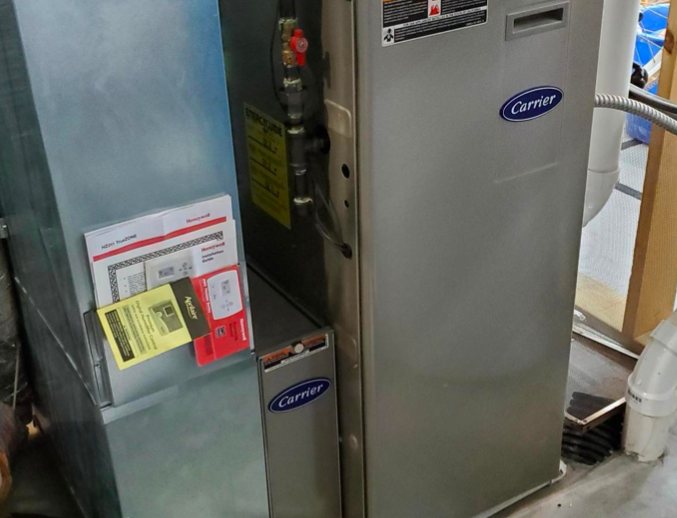
With the first access panel removed, you can see the flow inducer motor. If your flow inducer motor is bad or noisy, follow this guide to replace it.
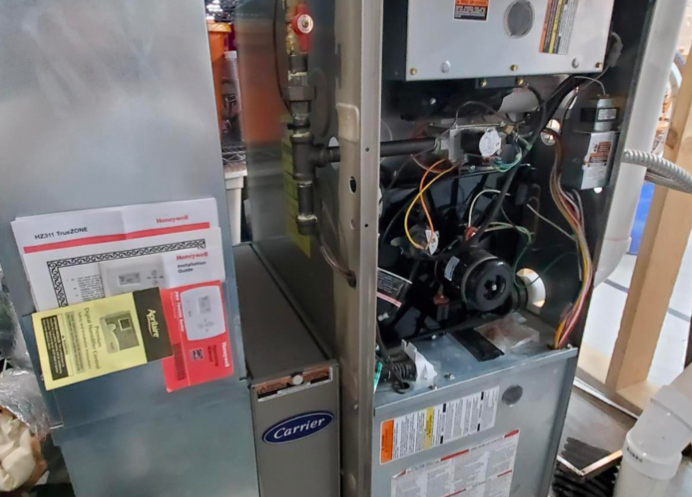
To get at the main blower, remove the lower access panel by removing the 2 sheet metal screws.
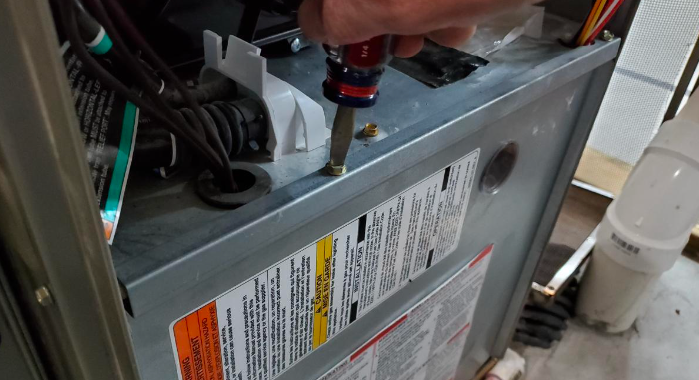
The lower access panel presses a safety switch. When the panel is removed, the blower will not run. Be sure to turn the system off at the circuit breaker and do not rely solely on this safety switch while performing repairs to your HVAC system.
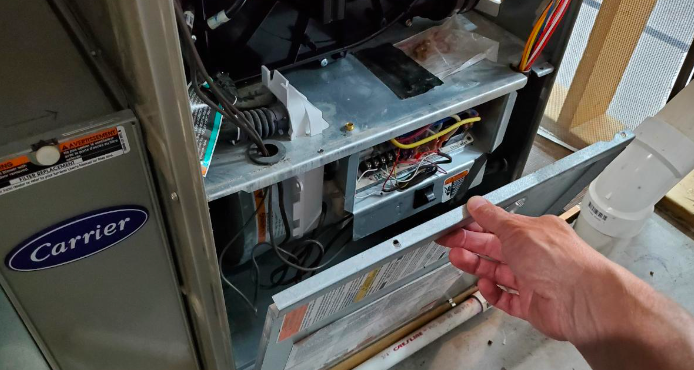
We need to get at the blower fan/motor. In order to do so, remove the panel holding the circuit board for the system.
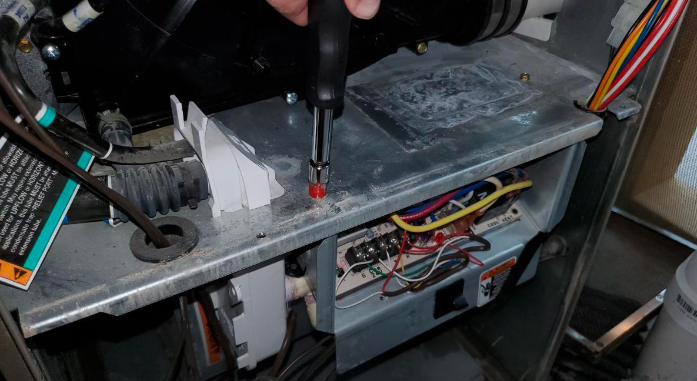
With the 2 screws removed, gently slide the circuit board out of the system.
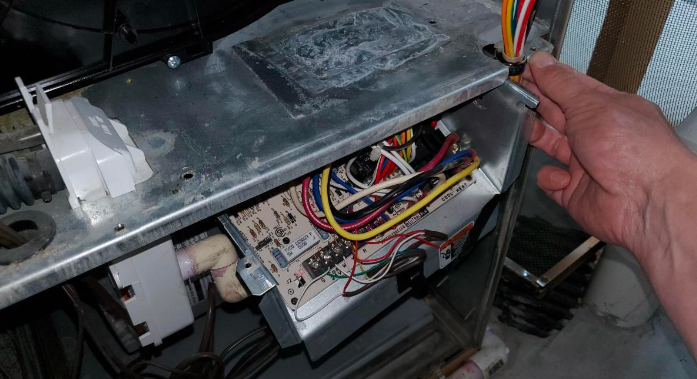
Leave the wires attached for now. We will disconnect the old blower motor in a subsequent step.
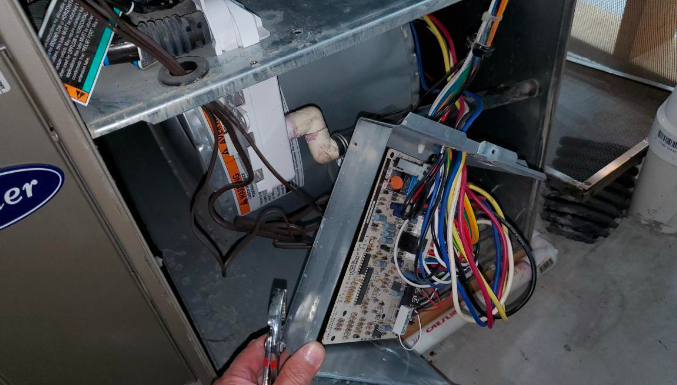
Next, remove the hoses attached to the drain trap, both top and bottom. A vise-grips works well for this step. A small amount of water may drain out when you remove the tubing.
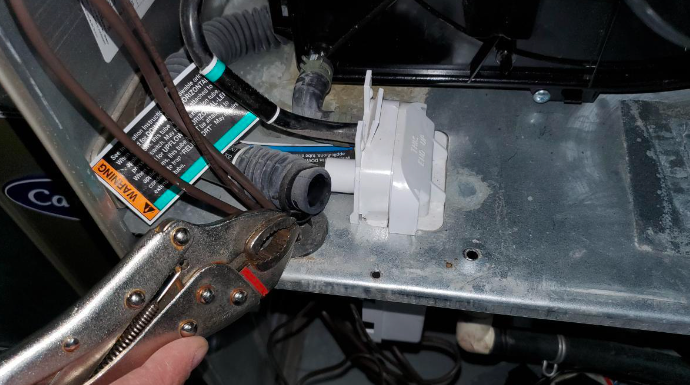
Once the tubing is disconnected, squeeze the two plastic tabs on the sides of the drain trap and tip it backwards to pull it down through the opening.
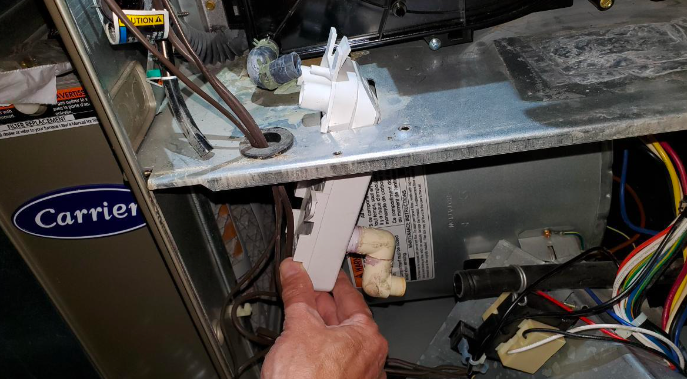
With the drain trap and the circuit board removed, you can see the blower motor and fan assembly.
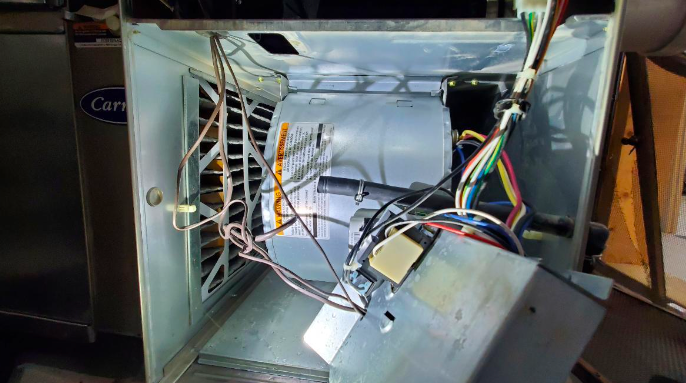
The fan body is held in place by two slots that it slides into to hold it up. It is held steady by two sheet metal screws.
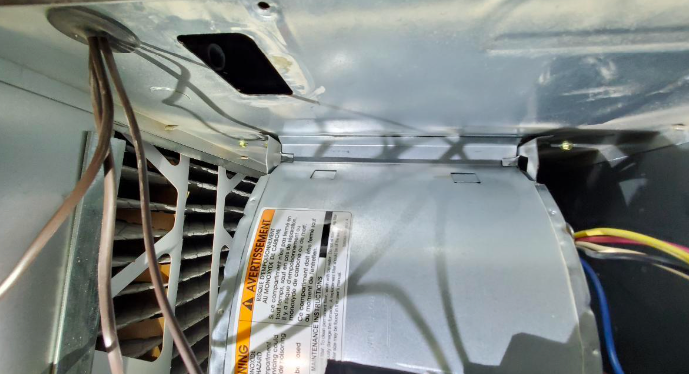
Remove both the screws, one on the left and one on the right.
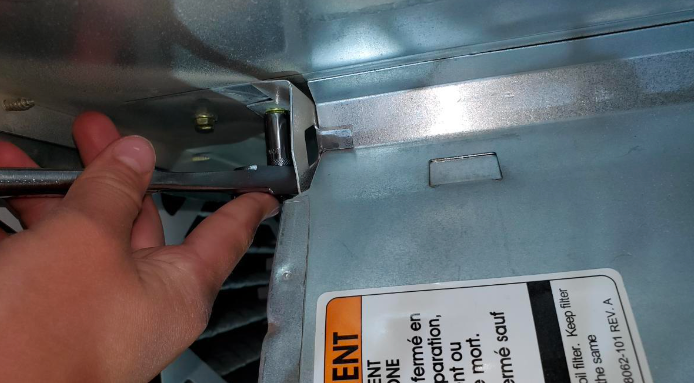
With the sheet metal screws removed, slide the blower fan and motor assembly out of the housing.
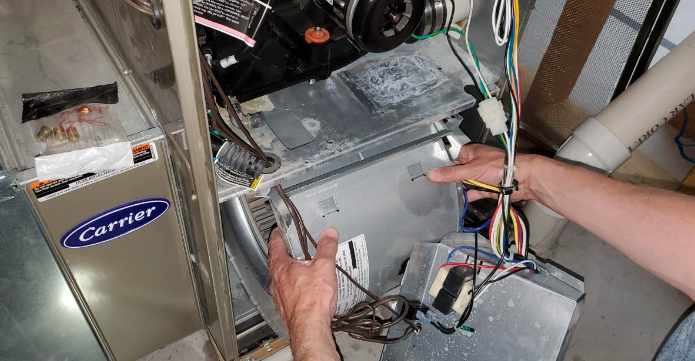
At this point, all of the wires are still attached. This is okay for now.
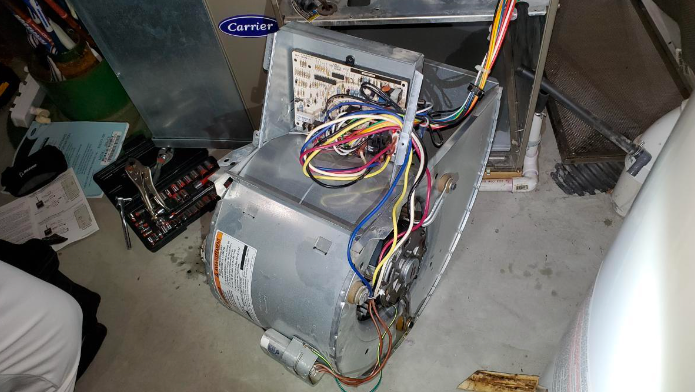
Now is a good time to inspect your blower fan. If it is dirty like mine was, clean it out with some compressed air and a rag.
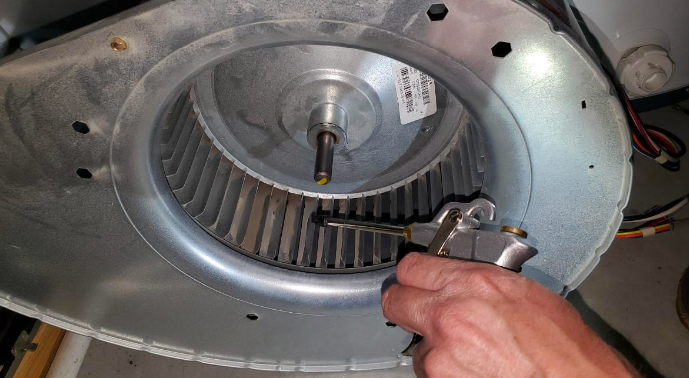
We are now ready to remove the old motor. Before you do that, be sure to take a few photos of the wiring connections. These pictures will come in handy later on.
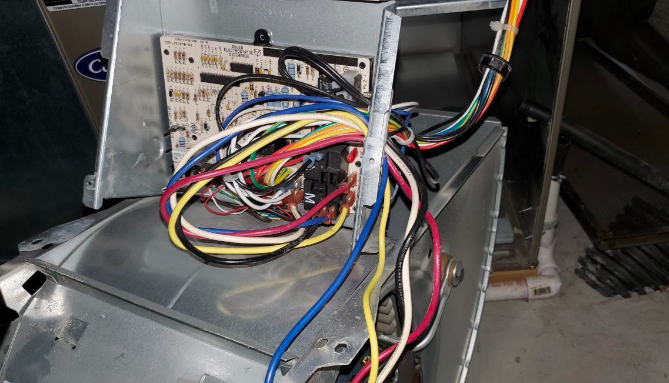
Here is a close-up of the 5 wires coming from the old blower motor and where they attach to the circuit board. Use a set of needle-nose pliers to gently pull the wires off of their posts.
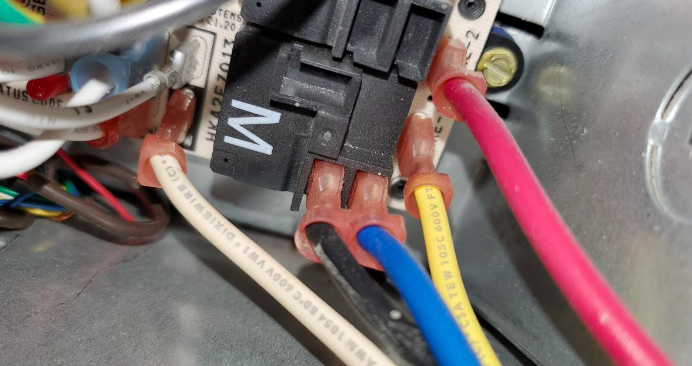
To remove the old motor, first remove the large capacitor strapped to the side of the fan housing.
Note: Capacitors store energy. To avoid getting a shock, short the 2 posts on the top of the capacitor by placing a plastic-handled screwdriver across both simultaneously, where the metal of the screwdriver touches both posts, and you only touch the plastic handle.
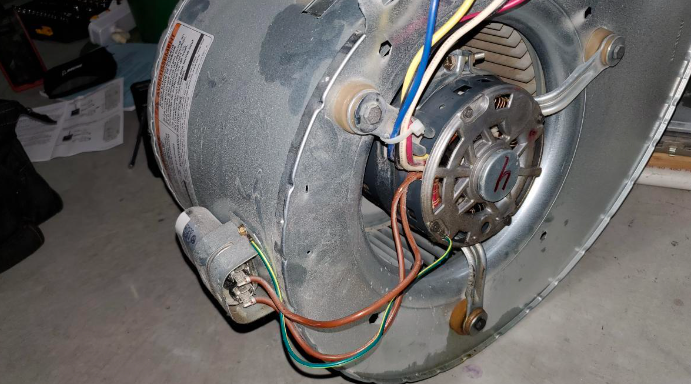
Use a socket or wrench to remove the capacitor mounting strap. Set it aside; you will not need it anymore.
The new ECM motor does not require the separate capacitor.
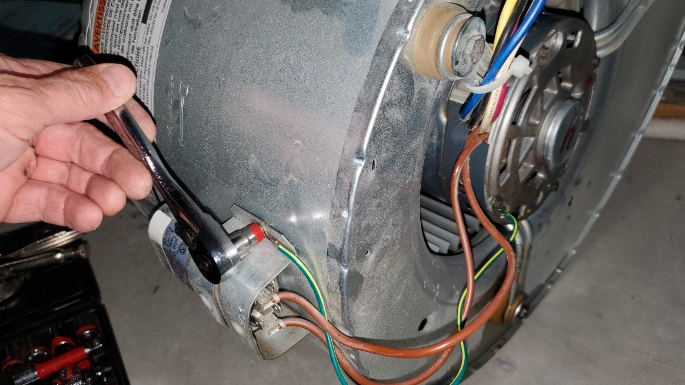
Next, use an adjustable wrench to loosen the locking screw holding the fan on the motor shaft. Consider wearing gloves, this screw will likely be tight and when it comes loose, it is easy to scrape yourself on the sheet metal housing. Once the screw is loose, leave the fan loosely on the shaft.
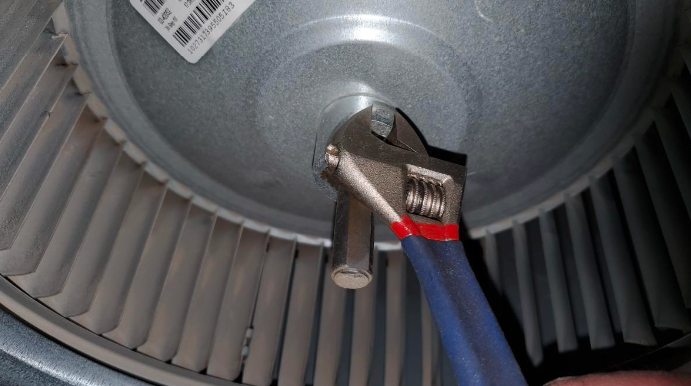
Now remove the 3 bolts holding the belly band supports for the old motor.
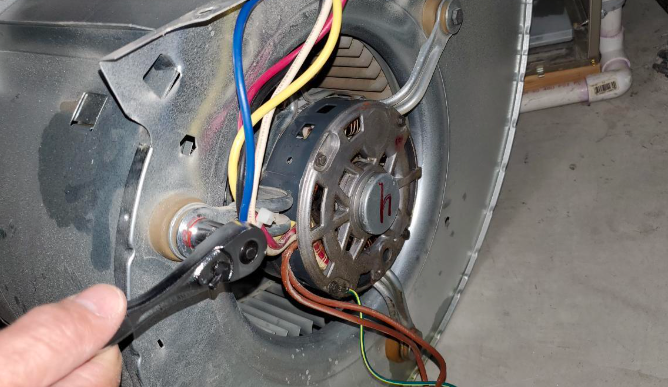
With the 3 bolts removed, slide the old motor out of the housing.
It often works best to flip the fan housing so that you are pulling the motor straight up.
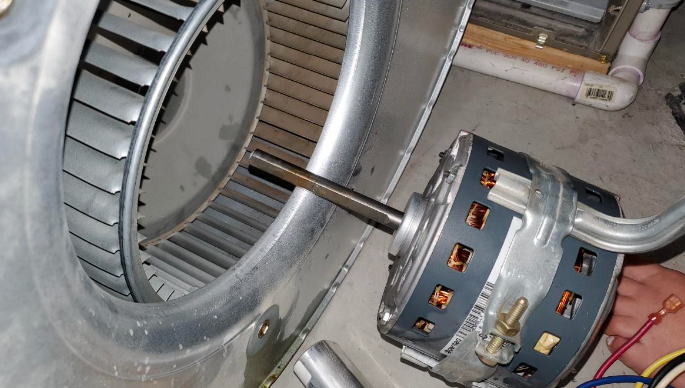
Here you can see the new (left) and old (right) motors side by side. When considering the cost of replacing the motor, if you go with another PSC motor, remember that you should also replace the capacitor at the same time. Once you consider both the motor and the capacitor, it is often more cost effective, even from the outset, to go with the ECM motor.
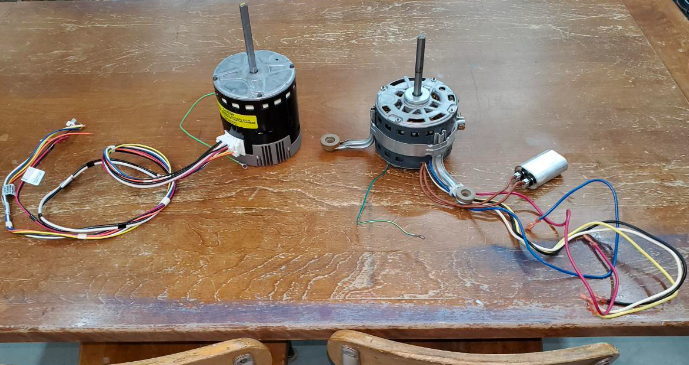
Before removing the mounting bracket (belly band), measure the distance from the top of the band to the front face of the motor.
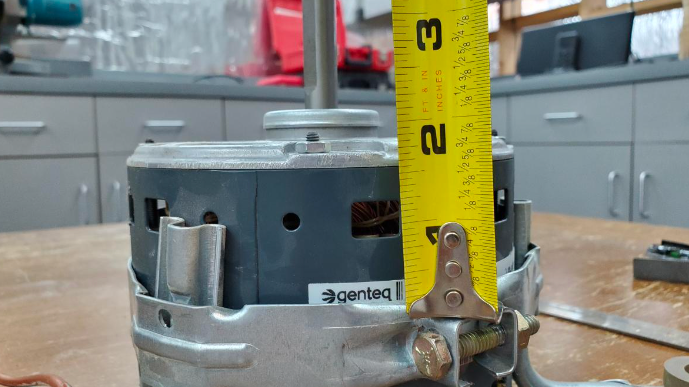
Remove the belly band from the old motor and put it on the new motor. Place the band the same distance from the front face of the motor.
Also, make sure that the wiring connector will be facing DOWNWARD or close to downward once the motor is installed. The reason for this is that you do not want water pooling inside the connector brackets in case condensation occurs.
Tighten the belly band in place.
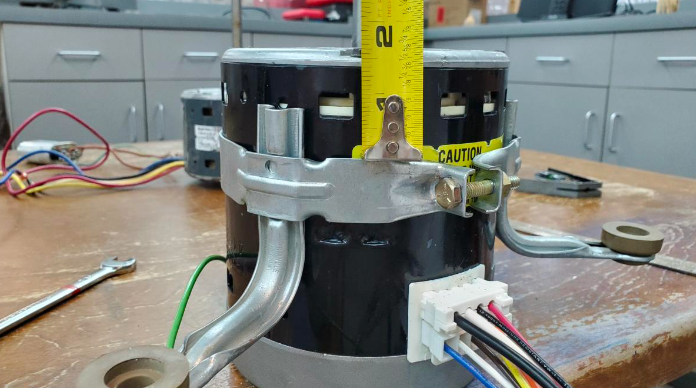
With the bracket installed, put the new motor shaft through the fan and line up the mounting holes. This is often most easily done by placing the fan assembly down on its face, so that the motor shaft is inserted straight down.
Insert and tighten up the 3 bracket mounting bolts.
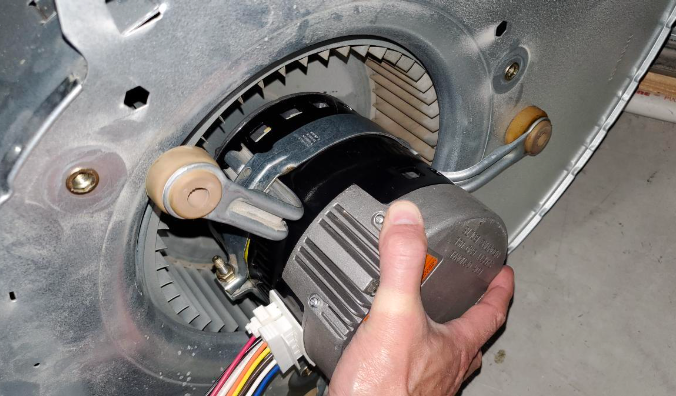
Next, tighten the set screw on the fan to the motor shaft. To make sure the fan is in the correct position, look into the end of the fan housing. Center the fan between the two sides as shown.
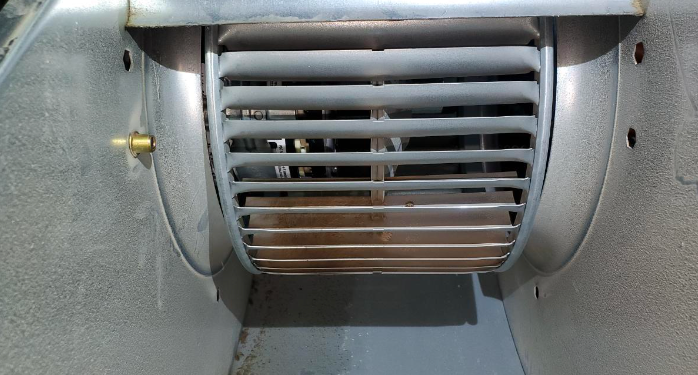
Once the fan is centered, use an adjustable wrench to tighten the set screw firmly.
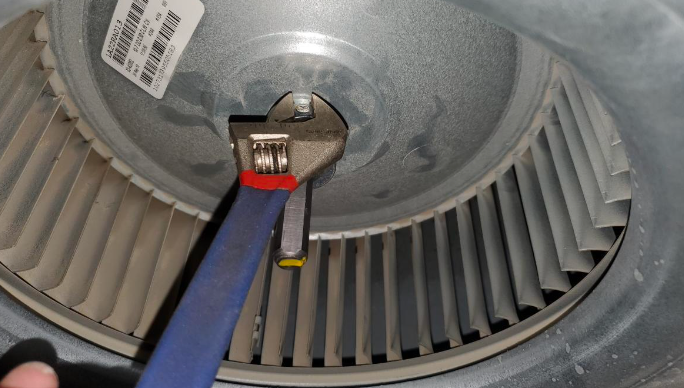
The new fan motor is now installed in the fan housing.
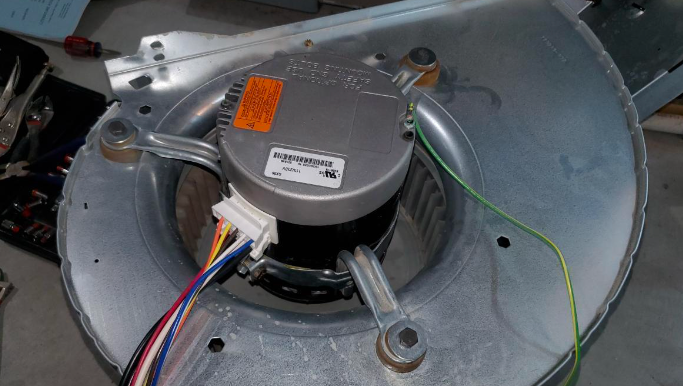
Here we can see that the wiring harness connectors are pointed roughly downward when mounted so that condensation does not collect in the connection area.
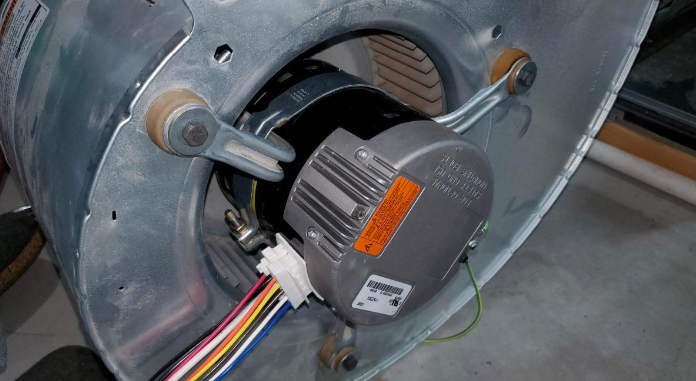
The grounding wire is the green/yellow one coming from the motor. Use the screw that held the capacitor band in place, to attach the grounding wire to the fan housing.
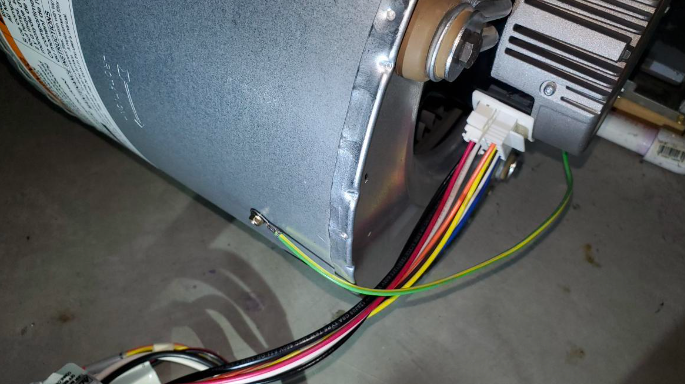
We're now ready to slide the fan housing back into place. Locate the two tabs on either side of the upper duct where the housing will slide in.
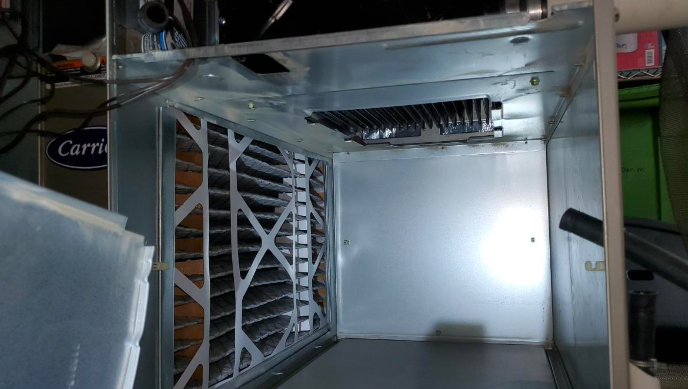
Position the fan housing for insertion.
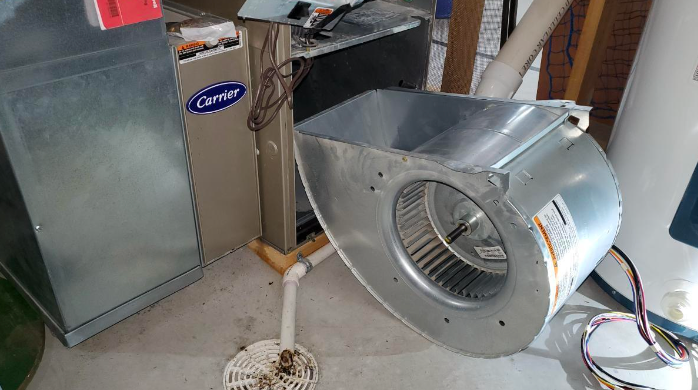
While lifting the fan housing, slide it into the tabs on the duct-work. Slide the fan housing all the way in and re-insert and tighten the two mounting screws that hold it in place.
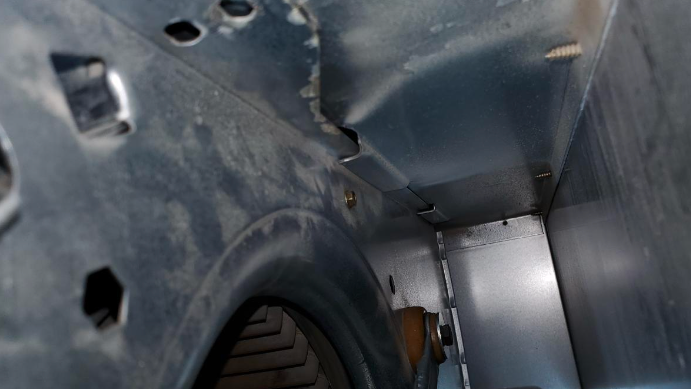
Next we'll work on wiring the new motor to the control board.
The installation booklet with wiring diagram is very good; it can be found here (pdf). This gives the full instructions for replacing a PSC (Permanent Split Capacitor) motor with an ECM (Electronically Commutated Motor), as we are doing here. Refer to page 6 as you follow along.
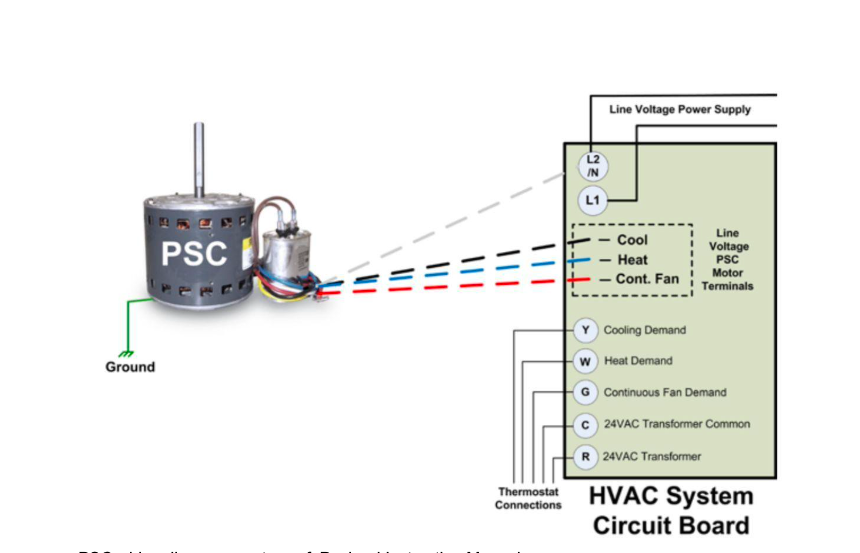
PSC wiring diagram courtesy of: Packard Instruction Manual.
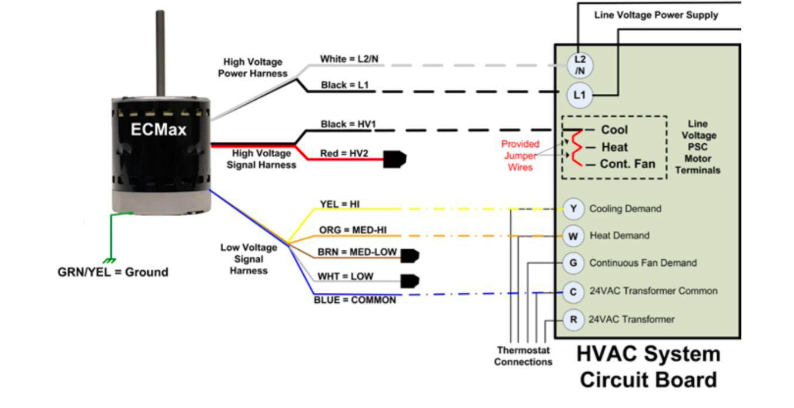
EC Max wiring diagram courtesy of: Packard Instruction Manual.
There are 3 main sets of wires. The white and black are taped together and go to the L1 and L2 pins, respectively. The black and red wire are also taped together. The black wire goes to the "Cool" port. Use one of the small red jumpers and a jumper clip to link the "Cool" and "Heat" pins together, as shown.
The red wire is not used in this configuration. It can either be capped off, or attached to one of the "Spare" ports on the side of the circuit board. The Spare ports do not connect to anything, they are just there to connect unused connectors to so that they aren't flopping around.
Note: The Spare ports are also sometimes labeled M1 and M2.
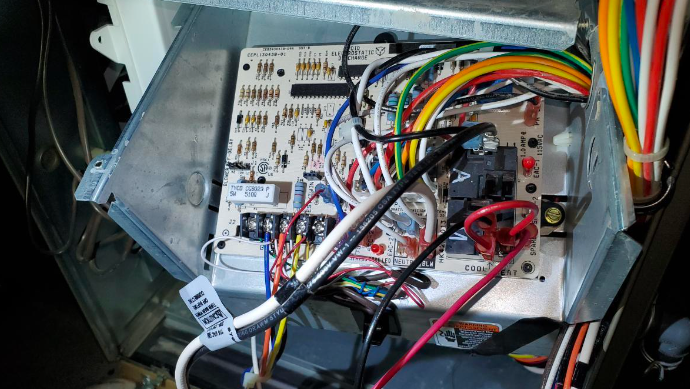
The low-voltage control wires go to the thermostat control portion of the board. In this case, we will only use the blue, orange, and yellow wires. The other two wires (brown and white) should be capped off.
The blue wire goes to the Const 24V port. The orange wire goes to the W port, and the yellow wire goes to the Y port.
Refer to the manual for other options including changing fan speeds.
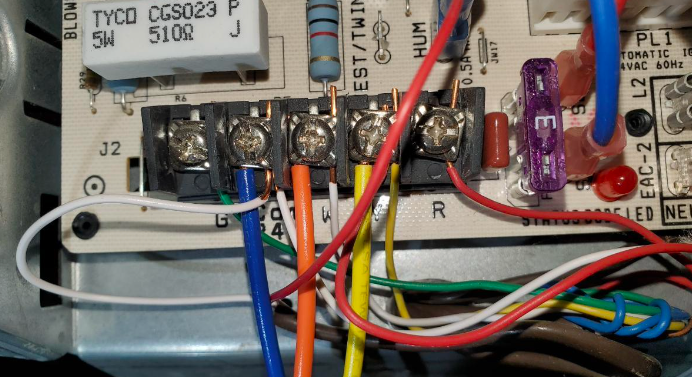
With the new motor wiring complete, route the wires appropriately so that they do not interfere with the motion of the fan, or the safety switch. Also confirm that the wires will not get pinched when re-installing the access panels. Then, zip-tie the wires in place.
Note: It is also a good idea to include a 'drip loop' in the wire bundle coming from the motor. This means that the wires exit the motor downward and reach a low point before going back up to the circuit board. Again, this has to do with condensation. If any water should condense on the wires, we want it to go to a low point and drip off, rather than running down into either the motor or circuit board.
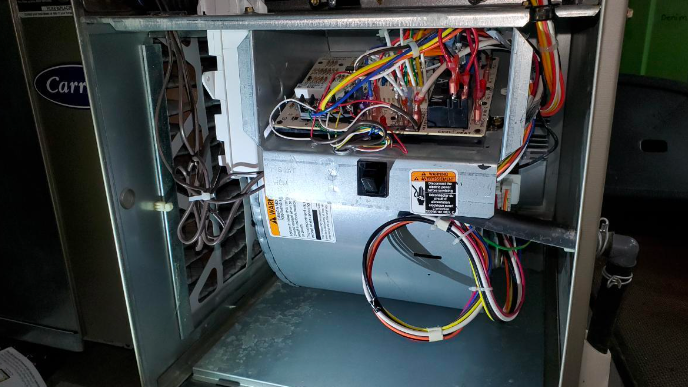
The wiring and installation of the new motor is now complete.
Re-install the access panels.
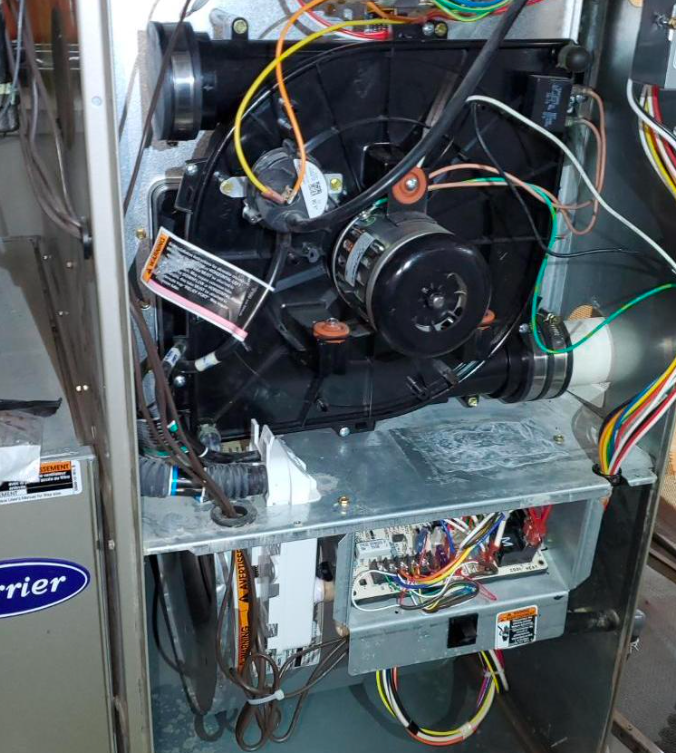
Once the system is completely put back together, verify no tools have inadvertently been left inside and that everything is put back together correctly. Then turn on the power and test the system in all operating modes.
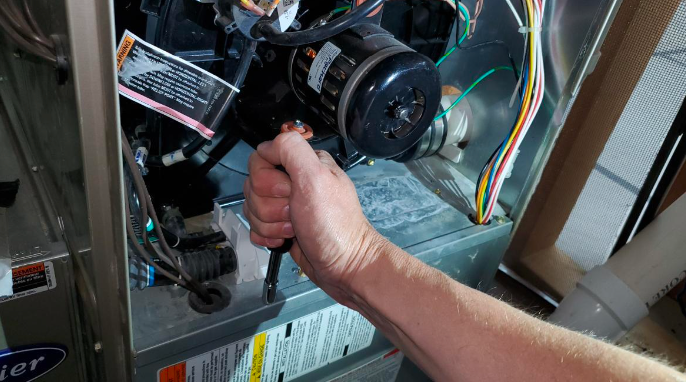
Conclusion
The first thing I noticed after installing the Packard EC Max motor was how much quieter it was compared to the previous motor! Part of this is because the motor ramps up so slowly. You don't notice that it has turned on right away because there is an abrupt rushing of air, and in my system at least, there is less of the shuddering sound transmitted through the ductwork. The fan coming on is much more subtle.
I am also looking forward to the cost savings of running an ECM vs a PSC motor. The EC Max is a constant torque motor which is 80% efficient compared to the old motor which had an efficiency near 55% - 65%, and can decrease energy usage by as much as 75%.
I hope this guide was helpful for you! If it was, please let me know in the comments section!
Tools and Supplies Used:
-
New Blower Motor (EC Max)
-
Flat-bladed Screwdriver
-
Vise Grips
-
Needle-nose Pliers
-
Socket Set
Check out more articles from the practical mechanic by clicking this link: Practical Mechanic Website



Leave a comment